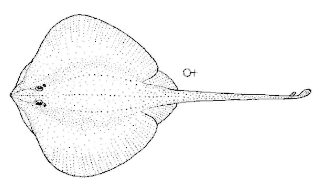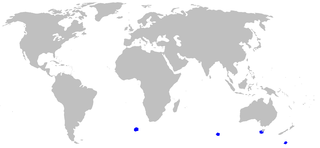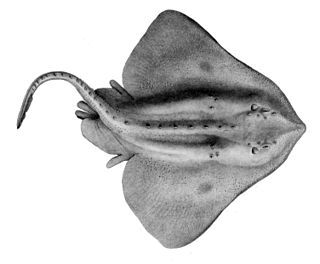The conservation status of a group of organisms indicates whether the group still exists and how likely the group is to become extinct in the near future. Many factors are taken into account when assessing conservation status: not simply the number of individuals remaining, but the overall increase or decrease in the population over time, breeding success rates, and known threats. Various systems of conservation status are in use at international, multi-country, national and local levels, as well as for consumer use such as sustainable seafood advisory lists and certification. The two international systems are by the International Union for Conservation of Nature (IUCN) and The Convention on International Trade in Endangered Species of Wild Fauna and Flora (CITES).

The leafscale gulper shark is a dogfish of the family Centrophoridae. C. squamosus is reported to have a lifespan of approximately 70 years, based on otolith ring counts. It was the first described species in the genus Centrophorus, which now contains 13 species.

The pygmy shark, the second-smallest of all the shark species after the dwarf lanternshark, is a squaliform shark of the family Dalatiidae, the only member of the genus Euprotomicrus. Their lengths are up to about 25 cm (10 in) for females and about 22 cm (8.7 in) for males.

The New Zealand smooth skate is a skate of the genus Dipturus, found around New Zealand at depths between 15 and 1,300 m.

The smooth deep-sea skate is a skate in the family Arhynchobatidae. It is found off New Zealand, at depths of from 200 to 1,300 m on the continental shelf. Their length is from 30 to 50 cm.

The prickly deep-sea skate, or spinydeep-sea skate, is a deep sea skate in the family Arhynchobatidae. It lives off New Zealand, at depths of from 170 to 1,400 m on the continental shelf. Their length is from 60 to 80 cm.

The longtail skate is a skate and is the only member of the genus Arhynchobatis. This species was first described by Edgar Ravenswood Waite in 1909. It is found off New Zealand at depths of from 90 to 1,000 m on the continental shelf. Its length is from 30 to 75 cm.

The dark ghostshark is a shortnose chimaera of the family Chimaeridae, found on the continental shelf around the South Island of New Zealand. In June 2018 the New Zealand Department of Conservation classified the dark ghostshark as "Not Threatened" under the New Zealand Threat Classification System.
The narrownose chimaera is a longnose chimaera of the family Rhinochimaeridae, the longnose chimaeras, consisting of eight species belonging three genera. This species is found in temperate seas worldwide, at depths between 200 and 3,100 m. Its length is between 1.0 and 1.5 m, including a long, tapering snout and a long, filamentous tail.

The sherwood dogfish or Sherwood's dogfish is a very rare sleeper shark of the family Somniosidae, found only around New Zealand. The only specimen studied was about 80 cm long.

The spotted estuary smooth-hound or rig is a houndshark of the family Triakidae, found on the continental shelves and in estuaries around New Zealand. It is closely related to the gummy shark of Australia. Males can grow up to a length of 125 cm (49 in), while females can reach a length of 151 cm (59 in).

The whitetail dogfish is a very rare sleeper shark of the family Somniosidae, found from the eastern Indian Ocean round southern Australia to New Zealand, at depths of between 150 and 500 m. Its length is up to 1.1 m.
The Maugean skate or Port Davey skate is an endangered species of fish in the family Rajidae. Also known as the ‘thylacine of the sea’. It is endemic to Tasmania, only found in the brackish estuarine waters of Macquarie Harbour and Bathurst Harbour. The species was discovered in 1988 by Dr Graham Edgar. It was named in honour of René Maugé, a zoologist on the Baudin expedition to Australia, who died in Tasmania in 1802.
The New Zealand Threat Classification System is used by the Department of Conservation to assess conservation priorities of species in New Zealand.

Māui dolphin, Maui's dolphin, or Popoto is a subspecies of the Hector's dolphin —New Zealand's only endemic cetacean. Māui dolphins are only found off the west coast of New Zealand's North Island, and are now one of the rarest and smallest dolphin subspecies globally. A 2021 report issued by the New Zealand government suggests the population rests at 54 individuals, but when taking into account recent mortalities, the population could sit at fewer than 40 individuals. Both the Māui dolphin and South Island Hector's dolphin are threatened by commercial fisheries, including set-netting and trawling, recreational netting, and disease including toxoplasmosis and brucellosis. Low food availability may also be an issue for Māui dolphins, which may increase their susceptibility to climate change.

The Arctic skate is a species of fish in the family Rajidae. It lives near the seabed between 140 and 2,500 m deep in the Arctic Ocean and waters around Canada and northern and north-western Europe, in the northern Pacific Ocean, and in waters surrounding Antarctica and New Zealand.

Zearaja is a small genus of skates in the family Rajidae. It currently consists of four described species found in oceans off New Zealand, Tasmania and southern South America.
The longnose deep-sea skate is a large skate in the family Arhynchobatidae. It was first described in 1985 from specimens collected near New Zealand. It is known to be a deep-water skate, however lack of research trawls at depths past 1500 meters limits knowledge of the depths where the species can be found. The species is dark brown or grey, with an eponymous elongated snout. The species has been measured to be a maximum of 140 cm in total length, although size variation and growth patterns are not known.















